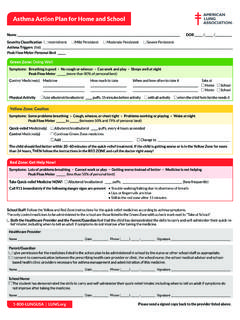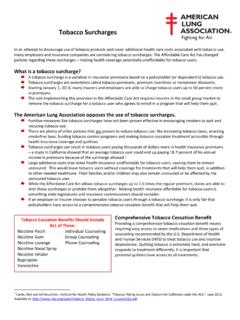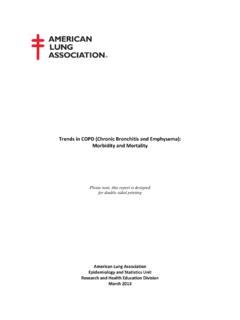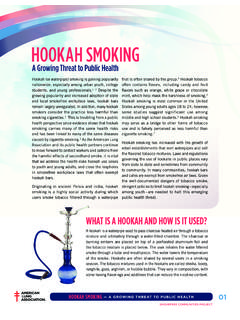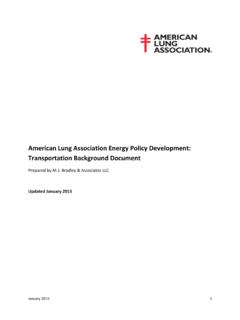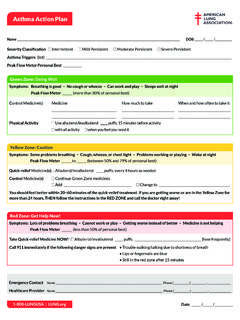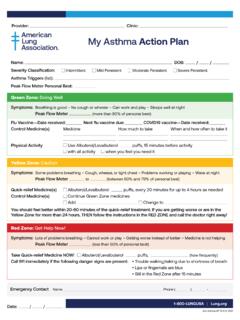Transcription of Billing Guide for Tobacco Screening and Cessation
1 Billing Guide for Tobacco Screening and CessationBilling Guide for Tobacco Screening and Cessation Tobacco use status is now embedded in most of the major electronic health records and evidence-based Tobacco Cessation counseling and pharmacotherapy covered by Medicare, Medicaid and most private health plans. Despite improved documentation and coverage, few providers bill for Cessation services. To help stakeholders ensure both the provision of Cessation services and payment for those services, this document gives an overview of Tobacco Cessation coverage requirements for Medicare, Medicaid and private insurance. While coverage is a critical component, payment for these services requires using the proper service and diagnosis codes.
2 This document also provides guidance on how to code for both diagnoses and services related to document is structured as follows: I. Coverage requirements A. Medicaid B. Medicare C. Private Insurance II. Coding and documentation requirements A. Diagnosis codes B. Procedure codes C. Documentation III. Reasons for claims denials IV. ResourcesThe information is intended for use by different stakeholders, including: State and local public health professionals working to increase delivery of Tobacco Cessation by health care providers Health systems and providers who are currently offering Cessation services and would like to be compensated for them Health systems and providers who have chosen not to provide Cessation services in the past due to lack of compensationApril 2021 | 1 Billing Guide for Tobacco Screening and Cessation I.
3 Coverage RequirementsMedicaid RequirementsThe Affordable Care Act (ACA) expanded Tobacco Cessation coverage for the Medicaid population, but gives states the ability to distinguish between the standard Medicaid and Medicaid expansion populations in terms of Cessation Medicaid Medicaid Pregnant Women: All FDA-approved Tobacco Cessation medications as well as individual, group, and phone counseling. No cost-sharing is permitted for pregnant women. Adults: All FDA-approved Tobacco Cessation medications. There is no counseling requirement. Cost-sharing is permitted. Adolescents and Children: Coverage of counseling and Tobacco Cessation medications is mandatory under the Early and periodic Screening , Diagnostic and Treatment (EPSDT) Expansion Coverage of counseling and Tobacco Cessation medications are required as part of the ACA s Essential Health Benefit under preventive and wellness services.
4 If a Medicaid expansion state chooses not to provide counseling to its standard Medicaid population, the expansion population will have better Cessation benefits. No cost sharing is Care and Fee for Service Medicaid managed care organizations (MCOs) are required to provide at least a comparable level of benefits to the fee-for-service option (77 percent of state Medicaid recipients are currently served by Medicaid MCOs). Most states with Medicaid MCOs use a risk adjustment methodology (See Documentation below). The same distinctions with respect to coverage and cost sharing may apply between standard Medicaid recipients being served by an MCO versus expansion Medicaid RequirementsMedicare Part B (provider component) covers two levels of Tobacco Cessation counseling for symptomatic and asymptomatic patients: intermediate (great than 3 minutes but no more than 10 minutes) and intensive (greater than 10 minutes).
5 Two Cessation attempts are covered per 12-month period. Each attempt may include a maximum of four intermediate or intensive counseling sessions, for a total of eight counseling sessions in the year. The patient may receive another eight counseling sessions during a second or subsequent year once 11 full months have passed since the first Medicare-covered Cessation counseling session took qualify for Medicare payment, the following criteria must be met at the time of service: Patients must be competent and alert at the time of the counseling is provided. Counseling must be provided by an MD or other Medicare-recognized health care 2021 | 2 Billing Guide for Tobacco Screening and Cessation Symptomatic PatientsSymptomatic patients are those who use Tobacco and: Have been diagnosed with a disease or an adverse health effect that has been found by the Surgeon General to be linked to Tobacco use; or Take a therapeutic agent for which the metabolism or dosing is affected by Tobacco use, based on information approved by the Food and Drug Administration (FDA) Both coinsurance and deductible are waived.
6 Asymptomatic PatientsAsymptomatic patients are those who use Tobacco but do not have symptoms of Tobacco -related disease. Both coinsurance and deductible are Insurance RequirementsThe Patient Protection and Affordable Care Act (ACA) requires most private health insurance plans to cover many clinical preventive services ( ). Preventive services include Tobacco Cessation Screening and treatment. The treatment include: Tobacco use Screening for all adults and adolescents Tobacco Cessation counseling for adults and adolescents who use Tobacco Food and Drug Administration (FDA) - approved Tobacco Cessation medications for all non-pregnant adults who use tobaccoMost private plans are required to provide evidence-based Tobacco Cessation counseling and interventions to all adults and pregnant women in accordance with the United States Preventive Services Task Force (USPSTF).
7 However, the USPSTF language does not provide certainty regarding exactly what is required. The USPSTF states: The USPSTF recommends that clinicians ask all adults about Tobacco use, advise them to stop using Tobacco and provide behavioral interventions and Food and Drug Administration (FDA) approved pharmacotherapy for Cessation to non-pregnant adults who use Tobacco . This is an A RecommendationThe Departments of Health and Human Services, Labor, and Treasury issued a sub-regulatory guidance in May 2014, which further clarified that health plans should cover Screening for Tobacco use and at least two quit attempts per year for Tobacco users. According to the guidance: Each quit attempt should include covering, without cost-sharing or prior authorization, of: Four counseling sessions of at least 10 minutes each (including telephone, group, and individual counseling), and coverage of all 7 medications approved by the Food and Drug Administration (FDA) as safe and effective for smoking Cessation for 90 days per quit attempt, when prescribed by a health care provider1.
8 April 2021 | 3 Billing Guide for Tobacco Screening and Cessation Private Insurance PerformanceThe National Alliance of Healthcare Purchaser Coalitions (National Alliance) annually fields a Request for Information called eValue . It is an in-depth assessment of health plan performance on critical processes that ensure patient safety, identify and close gaps in care, control costs, reduce and eliminate waste, and improve health and health care2. In 2015, the Centers for Disease Control Office of Smoking and Health (CDC) worked with the National Alliance to update the Tobacco questions. Plans responded in 2016 and analysis was completed in 2017. High level findings relevant to Billing include: Benefit coverage for Tobacco Cessation by health plans continues to improve, with particularly strong coverage for pharmaceuticals.
9 Plans do not appear to differentiate between their insured and self-insured groups as such, coverage is typically consistent across the health plan. Guideline-consistent in-person or telephonic counseling coverage is frequently offered; gaps in group counseling are the most prevalent. In general, with improved coverage, providers are encouraged to submit claims for Tobacco Cessation services provided to patients. However, benefits are subject to specific plan policies. Patients and providers should check with individual Medicaid, MCO and private insurance plans to determine what specific treatments are included and the extent to which these treatments are What is Covered?Patients and providers should check with individual Medicaid, MCO and private insurance plans to determine what specific treatments are included and the extent to which these treatments are covered.
10 Questions to ask payers would include: 1. Are both individual and group counseling covered? 2. Are there limits on the number of counseling sessions (either individual or group)?3. Are there any restrictions on what provider types may bill for counseling? (MD, NP, PA, etc.)4. Are there specific notes that must be included in documentation for counseling?5. Is there coverage for nicotine replacement therapy (patch, gum, inhaler)? Can it be over the counter or must it be prescription to be covered? 6. Is there coverage for bupropion? Is there coverage for varenicline? 7. Are there any prior authorization or step therapy requirements? 8. How many fills are allowed per patient per year? 9. What should my patient expect in terms of cost sharing?
